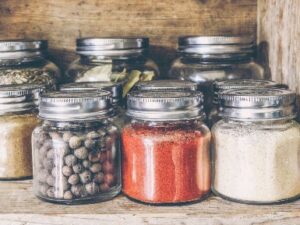
Downsizing a kitchen can be a real challenge for those who love to cook and entertain. Even a modest reduction in cabinet and counter space requires substantial adjustment, and many downsizers need to dramatically slim down their inventory of kitchen wares. However, downsizing doesn’t mean you can’t continue to prepare your favorite dishes for yourself and your guests in a new, smaller kitchen. Our friend and accomplished home cook, Helen Albanese, recently relocated to a continuing care community in Atlanta and offers these details about how she has adapted to her tiny new kitchen.
Essential Tools for a Tiny Kitchen
Safety First
Helen’s new apartment kitchen features storage shelves and cabinets placed at a height beyond her comfortable reach. Because frequently used items must be stored on these high shelves, a sturdy stepstool has become her must-have kitchen tool.
Attractive and Practical Spice Storage
Helen enjoys storing her spices in a set of attractive white spice racks that live on her counter. She transfers spices into the clear glass bottles that came with the racks, and keeps them in alphabetical order with typed labels on the lids for quick reference. Helen loves the uniform and uncluttered look, and the racks are sufficiently compact to provide workspace in front for easy access to the spices as she needs them.
Sharp Knives
The most basic kitchen tool of all is a sharp knife. Now that space is at a premium, Helen has found that she can get by with only a few kitchen knives. She recommends holding onto your favorite paring knife, then another medium-sized knife with a 6- or 7-inch blade, and then up to three specialty knives that you prefer, such as a chef’s knife, tomato knife or small carving set. Helen emphasizes that it’s safer to wield a sharp knife, and she sharpens her blades frequently. She uses both honing steel and her late grandmother’s small whetstone almost daily.
Cooking Pots
Helen gets the most use out of flat bottom, 5-ply 304 surgical steel pots that sit flat on her glass top range. The tight lids speed cooking and help retain nutrients. If space allows, she recommends retaining one favorite larger pot, like a Dutch oven, to cook voluminous leafy greens, dried beans, pastas, braises, and stews. Even though you may no longer be batch cooking, a deep and wide pot is less likely to boil over and is safer for simmering without burning food.
Kitchen Utensils
Typical home cooks may harbor dozens, if not hundreds, of hand tools, gadgets, and utensils. Helen’s downsizing move required her to reduce her collection by 75%, including cherished pieces from her mother. She now lives and cooks comfortably with one or two of each utensil quickly visible in her two uncluttered utensil drawers. She has found that any food prep can be accomplished with a sharpened knife and a carefully curated collection of other tools that include:
- Long-handled wooden spoons – they are lightweight and eco-friendly, plus they never scratch, react, or get hot. Helen saved four wooden spoons in four sizes, and she puts them in the dishwasher as she has done for years – even though directions always say hand wash.
- OXO Good Grips Stainless Steel Scraper & Chopper – for baking, cleaning up and transferring chopped vegetables to a cook pot, salad bowl, or storage container.
- Vegetable peeler – for fruit and vegetable peeling.
- European measuring spoons – with metric and imperial measurements, which she had a friend purchase abroad.
- Dry measuring containers – also with imperial and metric markings.
- Silicone whisk – which she uses daily and rinses quickly after using.
- Silicone spatulas – including one medium and one slim, ideal for stirring and cleaning out corners of pans and jars.
- Swing-A-Way manual can opener – Helen swears by this never-fail tool to get the job done. After electrical outages and buying several “designer” electric can openers that did not function as advertised, she returned to her trusted Swing-A-Way.
- Old toothbrushes – which she uses to scrub vegetables, pots, dishes, and food dried on kitchen surfaces. Run through the dishwasher with every load she suggests.
- Adjustable dividers in drawers – allowed Helen to customize the tiny space to fit her entire downsized collection. Everything is laid flat and visible, with nothing stacked. She says she has neither cut nor scratched her fingers once since using this adjustable divider system to hold her abbreviated knife and tool collection.
Storage
Pyrex clear glass containers with airtight silicone covers are exclusively how Helen stores batch-cooked and leftover foods. She retained all her 6, 4, 3, and 2 cup Pyrex containers and covers. She cooks twice a week and finds these airtight containers allow an extra day or two of safe refrigerated food storage, and they stack perfectly in the freezer.





